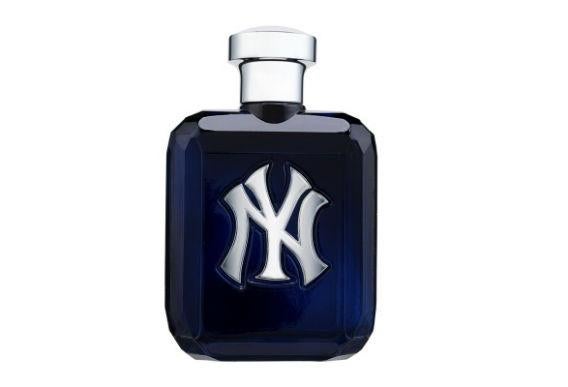Lately I’ve seen subway cars plastered with ads for New York Yankees-themed fragrances. According to the product website, the scent (soon to be available for online purchase) “epitomizes the winning style of the greatest team in baseball.” The men’s cologne boasts hints of “sparkling bergamot, coriander, and cool blue sage.” The women’s version adds notes of “juicy guava, succulent plum, and sun-kissed apricot nectar.”
Which made me wonder a few things. Like: What do bergamot and guava have to do with baseball? Wouldn’t a more authentic scent distill chunks of infield dirt, outfield grass, and mustard-laden hot dogs? And, more broadly, how far is it possible to stretch a brand before it breaks?
The Yankees are by no means the first organization to slap its logo on a product seemingly outside its traditional wheelhouse. The website of the consultancy Brand Extension Research lists several kinds of brand experimentation. Examples include “benefit owned” (Arm & Hammer was already known for deodorizing refrigerators with its baking soda, so it could credibly offer the same benefit in other realms by deodorizing armpits and kitty litter boxes); “companion product” (Aunt Jemima made pancake mix, so it made sense to offer pancake syrup, too); and “expertise” (Honda’s talent with engines makes it a trusted brand in categories ranging from cars to lawnmowers to generators).
While category shifts like these appear relatively natural, other examples might seem less so. Virgin—under the mercurial guidance of leader Richard Branson—has flitted, with varying degrees of success, among music, air travel, cola, and space tourism. The French company Bic has made disparate products including lighters, pens, razors, and even (at one time) pantyhose.
With Virgin, the unifying theme is Branson himself, and his endless quest to tackle massive challenges and do it better than the other guys. The customer is meant to associate all these varied Virgin products with Branson’s toothy grin and cheeky attitude. The brand’s overarching promise is that Branson gives you his personal assurance of quality and value.
With Bic, those leaps from product to product may seem random but in fact follow a logical progression. Pens, lighters, razors, and pantyhose are all compact, practical, and disposable. Even the failed attempt to market pantyhose in the 1970s had reasoning behind it: Bic imagined female administrative assistants buying pens for their offices and stocking up on hose along the way.
Sometimes a brand will create a sub-brand. For instance, IKEA has begun offering IKEA PS collections every three years. The collections are themed and employ trendy designers. They are less about reaching a different category of customer (the prices are similar) than about regularly reinvigorating IKEA’s image before it threatens to go stale. When there’s nothing truly new to say about your brand, a new collection with some panache provides an excuse for a publicity blitz.
Sometimes the goal of a sub-brand is to reach a new type of customer. One such sub-brand is L.L. Bean Signature, which debuted in March 2010 and happens to be of personal interest. I grew up with L.L. Bean backpacks and moccasins, but as I moved into my 30s I found the outfitter’s clothes a bit fuddy-duddy. Recognizing an unmet opportunity among shoppers like me, L.L. Bean sought a means of marketing slightly younger-skewing apparel without debasing its reputation for traditional, high-quality outdoor gear.
Gilly Hong, vice president of L.L. Bean Signature, told me that while the core consumer for L.L. Bean is age 45 to 55 and up, Signature’s target is more like 35 to 45. Her description of Signature’s mission is “updated classics.” While she declined to identify competitors, I sensed that J. Crew—with its conservative, upscale basics and recent run of success—was squarely in her sights.
One possible danger is that the new sub-brand will cannibalize the original, and Hong says she’s conscientious about not letting Signature encroach on its parent brand’s turf. “Both lines might have a shirtdress. But the Signature shirtdress will be more fitted, with less coverage, a shorter length, and more premium materials and fabrication.” It will also cost more.
According to Hong, the moments when Signature has gone awry have all stemmed from attempts to venture too far from L.L. Bean’s established image. “It’s when we’ve gotten too fashion-forward that we’ve encountered problems,” she says. “The consumer isn’t expecting something straight off the catwalk from L.L. Bean.”
Which brings us back to the Yankees. Is anyone expecting a cologne from a baseball team? Probably not. But this endeavor fits more into the category of licensing than sub-branding or brand extension. It’s akin to those shot glasses that say “Harley Davidson” on them. The buyer doesn’t care that Harley isn’t manufacturing the shot glass, and is instead simply lending out its logo. And a Yankees fragrance isn’t premised on the idea that the Yankees have expertise in creating scents, or that eau de toilette and baseball are natural companion products.
In cases like these, it’s not about the brand declaring itself an able master of a new product category. It’s about letting the consumer use the brand as a mark of self-identity. You don’t spritz yourself with eau de Yankees because you think Derek Jeter has olfactory wisdom—you do it because you want to associate every part of your life with Yankees baseball. Or because you want to smell (as of this writing, at least) like fourth place in the AL East.
